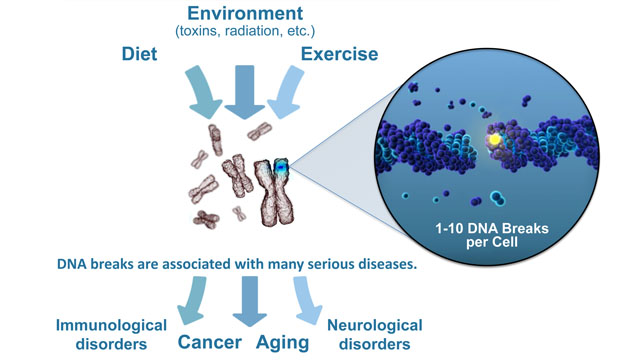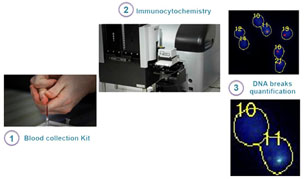
DNA stores the genetic information in each living cell, so its integrity and stability is essential to life. But it’s constantly being damaged by environmental factors like exposure to ionizing radiation, ultraviolet light and toxins. And DNA replication is also prone to error during normal cell division, so your body is busy constantly repairing damaged DNA. However, sometimes this normal DNA repair process fails, causing damage and genetic mutations to accumulate which leads to serious health problems like cancer, immunological disorders and neurological disorders.
If your annual checkup included a simple blood test to determine how much DNA damage you have in your body, you may be able to optimize your long-term health by taking action to minimize DNA damage due to your diet, exercise and environment. A startup company called Exogen Biotechnology wants to provide the public with a way to monitor their DNA health, so they can act to reduce damage. Exogen has developed technology that can rapidly quantify a type of DNA damage called double-strand breaks.
“DNA double-strand breaks are when the two strands of the DNA are cut, so they can move apart,” explained Sylvain Costes, a staff scientist at Lawrence Berkeley National Laboratory and co-founder of Exogen. “This is linked to mutation and chromosome rearrangement, so it’s a big deal – it’s the dangerous type of DNA damage. That’s what we look at.”
Exogen’s DNA damage measurement is based on technology developed over 15 years ago called immunocytochemistry – a technique that uses a primary antibody that recognizes the protein that is repairing the DNA break, along with a secondary fluorescent antibody that binds to the primary antibody. This creates bright spots in the microscope image where there are double-strand DNA breaks, so scientists can take a picture and count the breaks.

Exogen is moving this technique out of the laboratory to make it publicly available. They have significantly improved the technology so that it’s feasible to rapidly test small blood samples for the level of DNA double-strand breaks. A customer collects tiny blood samples using an in-home kit, combines the blood samples with a fixative solution to preserve them, logs on to the Exogen website to register the samples and complete a questionnaire, then mails them to Exogen for analysis.
